Femia > Health Library > Your cycle > Health > Reverse Kegels: What they are, how to do them, and their benefits
Reverse Kegels: What they are, how to do them, and their benefits

- Updated Mar 2, 2025
- Published
CRAFTED BY HUMAN
Crafted by human At Femia, we provide accurate and up-to-date information at every stage of your journey, from trying to conceive, pregnancy and postnatal support. All content is created by a real person based on in-depth research and own professional experience. Femia ensures that you will receive expert advice, strict accuracy and a personalized approach from our authors/medical experts. Learn more about our editorial policy.
FACT CHECKED
Fact checked At Femia Health, we maintain the highest standards of editorial excellence in delivering content focused on helping you conceive, guiding you through pregnancy, and supporting you postpartum. Explore our content review principles to learn how we ensure the accuracy and quality of our health and lifestyle tips for every stage of your journey.
Reverse Kegels help train your pelvic floor muscles to relax. Like the more well-versed Kegel exercise, reverse Kegels engages the same pelvic floor muscles. The primary difference is that while traditional Kegels contract your muscles, reverse Kegels focus on relaxing and lengthening. This helps with reducing incontinence, improving your sex life, and tackling pelvic pain.
Our pelvic floor muscles go through a lot of strain during our lifetime, resulting in a declining ability to control the contraction and relaxation phases of these muscles. While traditional Kegel exercises focus on contraction, reverse Kegels are a lesser-known exercise that helps relax your pelvic floor muscles. Regular practice of reverse Kegels can improve your pelvic floor muscle strength. This can reduce pelvic pain and incontinence, as well as enhancing sexual health.
👉Find out more: Pelvic floor massage 101: How to relieve pain and improve function
What is a reverse Kegel?
As the name implies, a reverse Kegel focuses on the relaxation of your pelvic floor muscle, versus the focused contraction observed with conventional Kegel exercises. The aim of reverse Kegels is for you to explore the full range of contraction and relaxation of your pelvic floor muscles.
The ability to perform reverse Kegels is particularly useful for those who experience chronic pelvic pain syndromes or spasms, especially since excessive pelvic floor muscle tension is responsible for a lot of these conditions. Regular practice of Kegel exercises has been proven beneficial in improving pain and enhancing conscious use of the pelvic floor muscle.
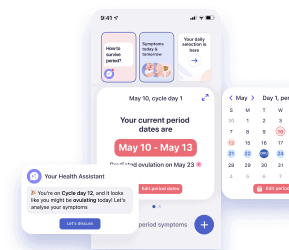
How to do reverse Kegels?
The first step to performing reverse Kegel exercises is to find the most comfortable place and position, either sitting or lying down. Reverse Kegels will have to be practiced several times a day, so having a comfortable and designated space helps with adding it to your daily routine.
Step-by-step instructions
- Once you are in a comfortable position, either lying down or seated, aim to have focused awareness of your perineum, which is the area between your anus and vagina. These are the primary muscles you will engage during the reverse Kegels.
- To focus on what relaxing the muscles feels like, you will first perform a Kegel contraction. A Kegel contraction is like stopping a stream of urine mid-way for a few seconds. Following this, you will release the contraction for a more focused relaxation phase—the reverse Kegel.
- Mindful breathing during the exercise can help you focus more on relaxing your pelvic floor muscles. As you take in a deep breath, known as a diaphragmatic breath, your belly will expand. This deep breath helps to relax and lengthen your perineal muscles.
- As you slowly exhale, attempt to maintain the relaxed state, as if you were bearing down to pass urine or a bowel movement.
- Repeat these steps five to ten times per session, slowly increasing the amount of time your perineal muscles spend in relaxation.
Reverse Kegels can be performed in other positions as well, such as a child’s pose, a happy baby pose, or a downward dog position. Once you are more aware of the relaxation phase of your perineum, attempting it in other positions, even while standing, will help you gauge the control you have in both the contracted and relaxed states.
Quick tip: Before performing your reverse Kegel exercises ensure you have emptied your bladder, to reduce your urge to pee while training your perineal muscles to relax.
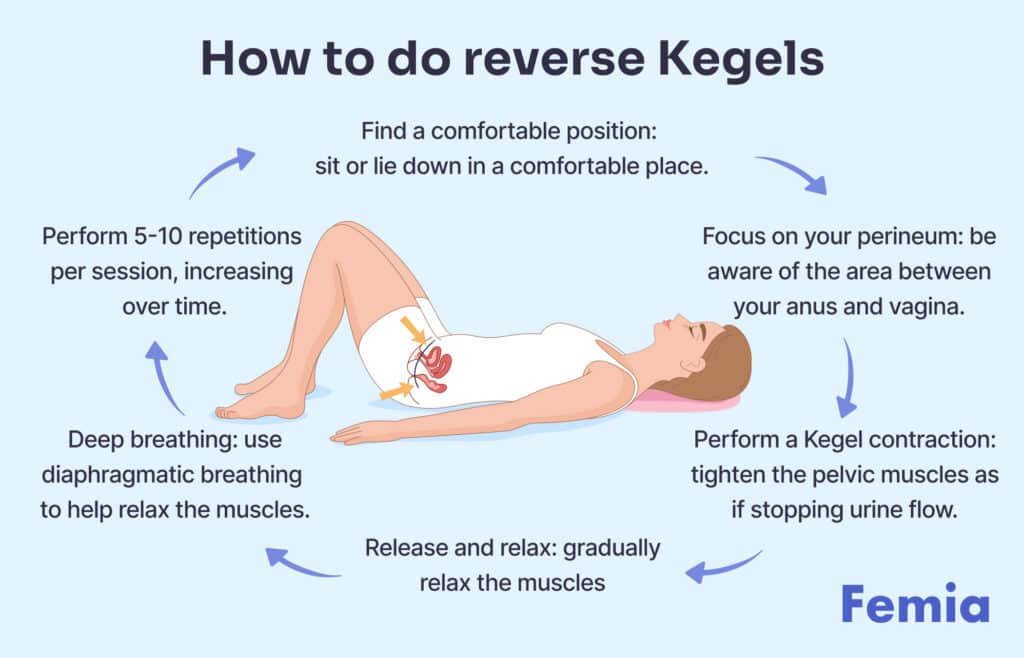
How often should I practice reverse Kegels?
There is no fixed number of times to practice reverse Kegels daily. Once you have been diagnosed with overactive pelvic floor muscles, you will initially be guided by a physiotherapist on how to reverse Kegel. Ideally, you start with doing them twice or thrice a day for a few repetitions. This is to prevent starting with too many exercises and to assess your comfort level. Over time, when you are capable of making the mind-to-pelvis connection and are more aware of the relaxed state of your pelvic floor muscles, you can try doing them three to five times a day, with up to ten repetitions in each session.
👉Find out more: Endometriosis self-care: tips for managing symptoms and boosting fertility
Reverse Kegels are not only recommended for those who have tight pelvic floor muscles. Everyone, both men and women, can practice a combination of Kegels and reverse Kegels to strengthen their pelvic floor muscles, helping reduce the risk of injury and promoting quick recovery when situations require it.
How long does it take to see benefits from reverse Kegels?
Based on when you start and the underlying reason for which you are practicing reverse Kegels, you will see reverse Kegel benefits at different stages. It can take a few weeks of regular practice just to become more aware of the relaxed state of your pelvis.
Following this, it might take a few more weeks to a few months to see noticeable changes in any underlying conditions. To reap the most benefits, you should make reverse Kegels a part of your daily routine.
What do reverse Kegels feel like?
Unlike Kegel exercises, reverse Kegels take more time to become an intuitive practice. It is easier to contract and feel the contraction of a muscle than to feel the relaxation phase our muscles often rest in. When you contract your pelvic floor, it feels like a lifting sensation. But during conscious relaxation, you will notice a slight bearing down or opening up of the lower pelvis.
With a reverse Kegel, your muscles are essentially lengthening to provide more space for all the organs present just above the pelvic floor muscles.
Some people experience excessive contraction of the pelvic floor muscles, which can cause pain and discomfort during sex, urination, or bowel movements. It is also possible to feel general lower pelvic discomfort, which can radiate to the back and cause further pain. In all of this, the muscles are unable to stay in a lengthened relaxed state.
By practicing reverse Kegels, you are consciously making attempts to improve this state of continued contraction and facilitate pelvic floor relaxation. So, at first, it will feel like an intuitive effort to feel for your pelvic floor muscles in a rested state. Over time, once you notice improvement, you may subconsciously favor a relaxed state for your pelvic muscles, as you have trained them to adopt the less painful relaxed state.
It is crucial to continue both Kegels and reverse Kegels even after you notice improvement. These exercises provide multiple long-term benefits, even for those who have not been diagnosed with an underlying condition.
👉Find out more: Signs of ovulation after stopping taking birth control pills
What are the benefits of doing reverse Kegels?
Your pelvic floor and its accompanying muscles protect organs such as the uterus, bladder, vagina, and parts of the colon, such as the rectum. A dysfunction in the pelvic floor muscles, either with too much or too little contraction, can result in a dysfunction of any of these organs.
For those advised to practice the reverse Kegel, the most common conditions result from overactive pelvic floor muscles. Signs of this can include pain during sex, while passing urine or stool, along with back or pelvic pain.
The primary reverse Kegel benefit is controlling the full range of flexibility in your pelvic floor muscles. Conscious relaxation can help with natural functions such as urinating, passing a bowel movement, and childbirth. Pelvic-muscle strengthening exercises have also been proven beneficial for associated pelvic and back pain.
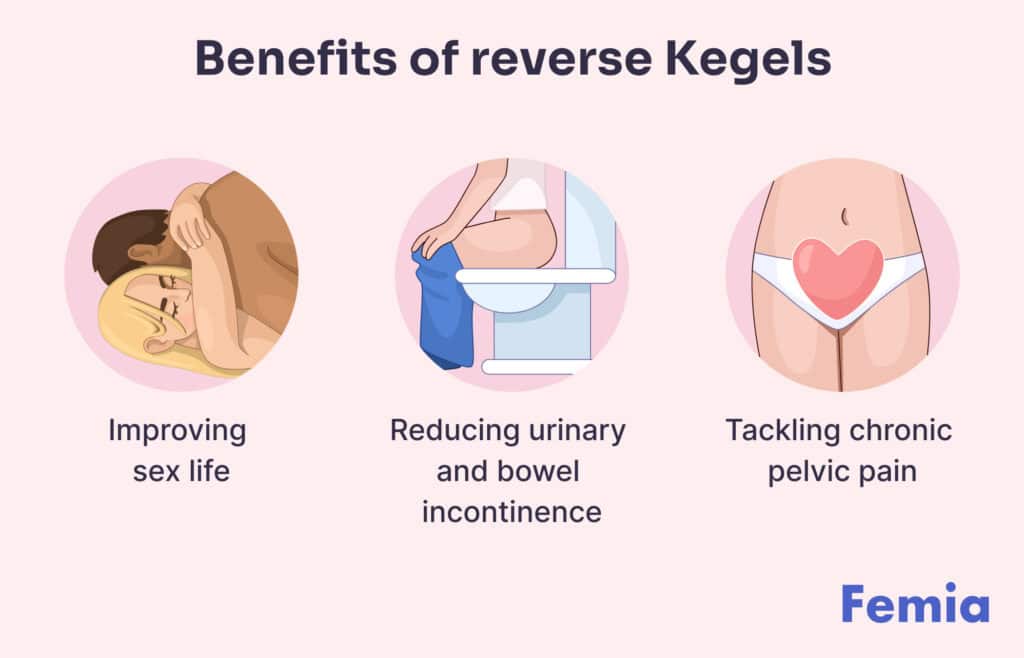

When should I use reverse Kegels?
While it is safe for most of us to routinely practice both traditional Kegels and reverse Kegels, it is best to first check in with your doctor to assess the base function of your pelvic floor muscles.
This becomes especially important if you experience pain during sex or while passing urine or stool. Sometimes, the source of your pain may not be linked to your pelvic floor muscles, and performing the reverse Kegels might worsen the pain.
👉Find out more: Toxic metals found in tampons: What you need to know
Currently, 3 to 18% of women worldwide experience dyspareunia, which is painful sexual intercourse. Weak and overactive pelvic floor muscles are a leading cause of dyspareunia. Similarly, pelvic floor muscles that are fatigued from rigorous exercise or prolonged constipation can also manifest as hypertonic pelvic floor muscles.
With any health condition resulting in tensed pelvic muscles, you will initially be guided by a physical therapist on how to reverse Kegel. Regularly performing these exercises under guidance can assist you in safely training your biofeedback mechanism to your pelvic floor muscles for relaxation, essential for treating conditions such as chronic pelvic pain syndrome.
Like with any exercise, stop immediately if your pain or underlying condition worsens. Wait for a while, get checked by your doctor, and then return to it when you have been given the green light. You should also refrain from performing the reverse Kegel if you have recently undergone surgery or have been diagnosed with any pelvic organ prolapse.
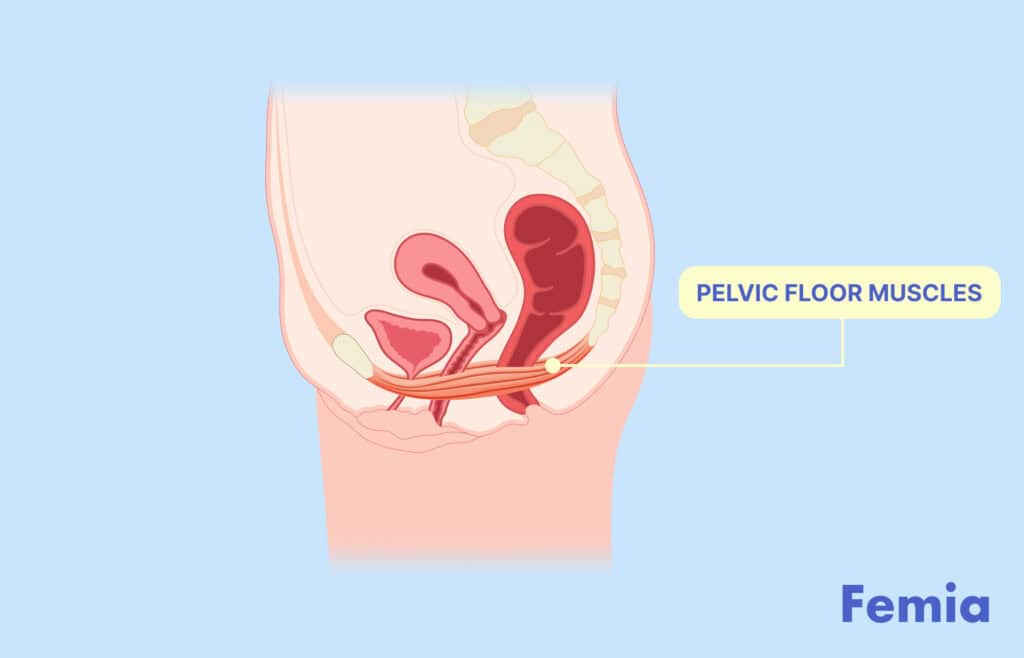
Questions from the Femia community
Are reverse Kegels suitable for both men and women?
Yes, contrary to popular belief, Kegels and reverse Kegels can be performed by both men and women. These exercises are meant to assess and train the flexibility of your pelvic floor muscles through manual contraction and relaxation. For men, reverse Kegels can help with erectile dysfunction, increased urinary frequency, and support circulation around the prostate.
Can reverse Kegels help with pelvic floor dysfunction?
Yes, reverse Kegels can help manage pelvic floor dysfunction along with other recommended treatment modalities. Regularly performing reverse Kegels can help improve the range of muscle flexibility often noticed with pelvic floor dysfunction.
Should I do reverse Kegels if I already do traditional Kegels?
While traditional Kegels help you to train your pelvic floor contraction, reverse Kegels focus on mindful relaxation. Since these exercises perform alternating tasks, doing them both regularly can help improve the range of flexibility in your pelvic muscle. For those who have an overactive pelvic floor, reverse Kegels are often advised, as increased contraction with traditional Kegels might cause more pain. Check in with your doctor before starting either of the exercises.
Can reverse Kegels be done during pregnancy?
Most definitely. Since reverse Kegels are the manual relaxation of your pelvic floor, it is the natural state in which you will be able to facilitate childbirth. Relaxation and bearing down is the basis for vaginal delivery. With regular practice of reverse Kegels, you will find it easier to relax your pelvis when the time comes to deliver your baby.
Can reverse Kegels help with chronic pelvic pain?
Tension and overactivity in the pelvic floor muscles are a leading cause of chronic pelvic pain. Reverse Kegels train your muscles to relax. Daily reverse Kegel exercises can help reduce pelvic pain within a few weeks or months.
Can reverse Kegels be a part of my postpartum recovery routine?
Absolutely! Since your pelvic floor muscles can be fatigued and even weakened from bearing down during both pregnancy and childbirth, a routine combination of Kegels and reverse Kegels can help improve postpartum pelvic floor muscle strength. Before starting these exercises, however, check in with your doctor, and assess your ability to perform the exercises.
The bottom line
After a check-in with your doctor, you can start doing reverse Kegels—exercises that help you to intuitively relax your pelvic floor muscles. Reverse Kegels provide the greatest benefit for those who have overactive and tense muscles in their pelvis. Tension in the pelvic floor muscles can manifest as an array of related pelvic pain syndromes. With regular fine-tuning of your reverse Kegels, you will be able to control your range of muscle flexibility, improve pelvic floor muscle control, and reduce pain symptoms over the next few weeks to months.
References
- Xu, Xin, et al. “Analysis of the Characteristics and Clinical Significance of Pelvic Floor Electrophysiology and Imaging Changes in Female Patients With MFPP.” Journal of Radiation Research and Applied Sciences, vol. 16, no. 4, 2023, p. 100713. https://doi.org/10.1016/j.jrras.2023.100713.
- Vural, Meltem. “Pelvic pain rehabilitation.” Turkish Journal of Physical Medicine and Rehabilitation vol. 64,4 291-299. 4 Nov. 2018, doi:10.5606/tftrd.2018.3616.
- Kazeminia, Mohsen, et al. “The effect of pelvic floor muscle-strengthening exercises on low back pain: a systematic review and meta-analysis on randomized clinical trials.” Neurological sciences: official journal of the Italian Neurological Society and of the Italian Society of Clinical Neurophysiology vol. 44,3 (2023): 859-872. doi:10.1007/s10072-022-06430-z.
- Tayyeb, Muhammad. and Vikas Gupta. “Dyspareunia.” StatPearls, StatPearls Publishing, 5 June 2023. https://www.ncbi.nlm.nih.gov/books/NBK562159/.
- Ghaderi, Fariba, et al. “Pelvic floor rehabilitation in the treatment of women with dyspareunia: a randomized controlled clinical trial.” International urogynecology journal vol. 30,11 (2019): 1849-1855. doi:10.1007/s00192-019-04019-3.
- Louis-Charles, Kaina et al. “Pelvic Floor Dysfunction in the Female Athlete.” Current Sports Medicine Reports vol. 18,2 (2019): 49-52. doi:10.1249/JSR.0000000000000563.
- Clemens, J Q et al. “Biofeedback, pelvic floor re-education, and bladder training for male chronic pelvic pain syndrome.” Urology vol. 56,6 (2000): 951-5. doi:10.1016/s0090-4295(00)00796-2.
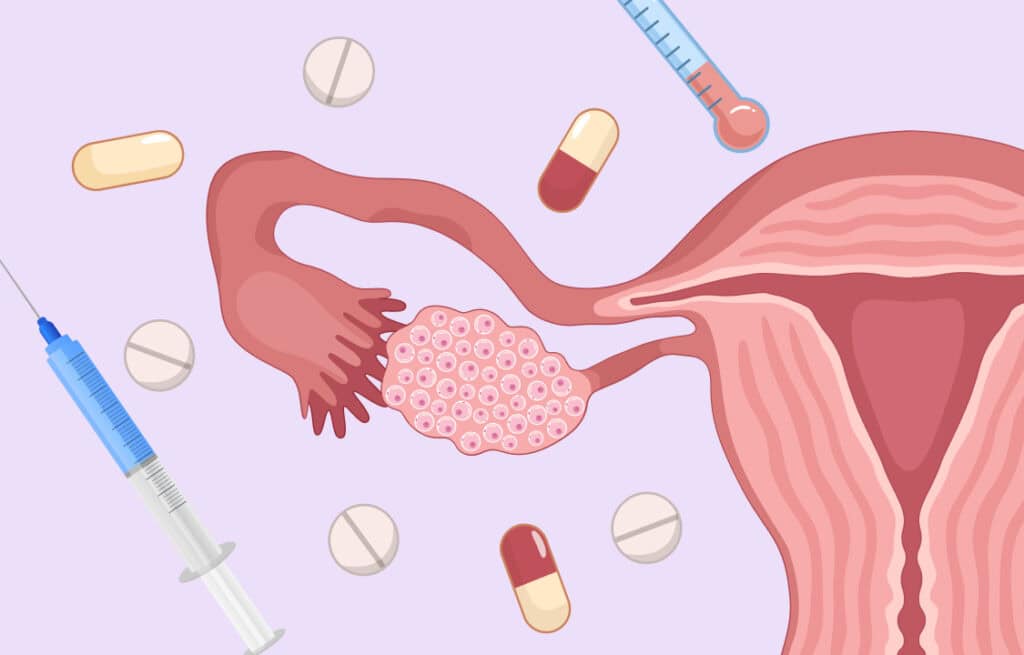
Let’s learn what OHSS means, its mild and severe symptoms, medical and self-care treatment options.

Wondering ‘Can you take antibiotics while breastfeeding’? Learn which antibiotics are considered safe, when to avoid, and tips to protect your baby and milk supply.
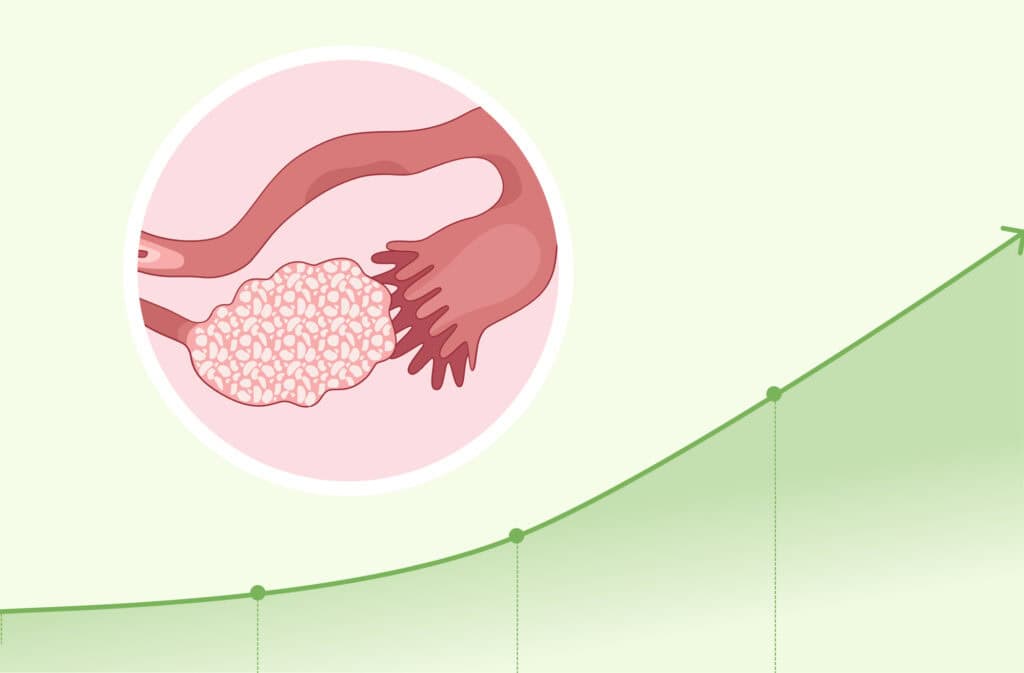
How to increase AMH levels for fertility? Click to read a definitive guide with practical tips for boosting AMH levels through dietary, lifestyle, and medical approaches.

